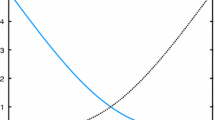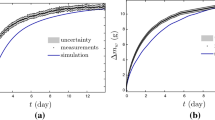Abstract
In the present work, the impact of water sorption hysteresis on the coupled heat/moisture transfer of building materials is investigated. After a review of the literature, the independent model of Mualem was identified and integrated into a simulation tool for coupled transfers. Then, a comparison between the simulation (with and without hysteresis) and experimental results was carried out for temperature, partial vapor pressure and relative humidity. This comparison shows that the integration of Mualem hardly changes the simulations. Further, this model has been modified and integrated into the same tool. The modified model has produced more convincing results as the error percentage of the relative humidity has been divided by a factor 2 (RH presents the highest error compared to other parameters). An analysis of the obtained results has revealed another hygrothermal parameter which is often neglected and could impact the hygrothermal modeling: the complementary sorption heat.













Similar content being viewed by others
References
Alizadeh M, Ganji DD (2021) Heat transfer characteristics and optimization of the efficiency and thermal resistance of a finned thermosyphon. Appl Therm Eng 183:116136. https://doi.org/10.1016/j.applthermaleng.2020.116136
Alizadeh M, Ganji DD (2020) Multi-objective optimization of an externally finned two-phase closed thermosyphon using response surface methodology. Appl Therm Eng 171:115008. https://doi.org/10.1016/j.applthermaleng.2020.115008
Alizadeh M, Ganji DD (2020) Heat transfer characteristics of an external-fin-assisted two-phase closed thermosyphon: an experimental study. Heat Transfer 49(8):4304–4320. https://doi.org/10.1002/htj.21828
Kumar R, Gupta V, Abbas IA (2013) Plane deformation due to thermal source in fractional order thermoelastic media. J Comput Theor Nanosci 10(10):2520–2525. https://doi.org/10.1166/jctn.2013.3241
Hobiny AD, Abbas IA (2020) Fractional order thermoelastic wave assessment in a two-dimension medium with voids. Geotech Eng 21(1):85–93. https://doi.org/10.12989/gae.2020.21.1.085
Horrigue S, Abbas IA (2020) Fractional-order thermoelastic wave assessment in a two-dimensional fiber-reinforced anisotropic material. Mathematics 8(9). https://doi.org/10.3390/math8091609
Marin M, Hobiny A, Abbas I (2021) The effects of fractional time derivatives in porothermoelastic materials using finite element method. Mathematics 9(14). https://doi.org/10.3390/math9141606
Saeed T, Abbas IA (2021) The effect of fractional time derivative on two-dimension porous materials due to pulse heat flux. Mathematics 9(3). https://doi.org/10.3390/math9030207
Hobiny A, Alzahrani F, Abbas I, Marin M (2020) The effect of fractional time derivative of bioheat model in skin tissue induced to laser irradiation. Symmetry 12(4). https://doi.org/10.3390/sym12040602
Hobiny A, Abbas I (2021) Analytical solutions of fractional bioheat model in a spherical tissue. Mech Based Des Struct Mach 49(3):430–439. https://doi.org/10.1080/15397734.2019.1702055
Abdalla A, Abbas I, Sapoor H (2022) The effects of fractional derivatives of bio-heat model in living tissues using analytical-numerical method. Information Sciences Letters 11(1):7–13. https://doi.org/10.18576/isl/110102
Ferroukhi MY, Abahri K, Belarbi R, Limam K, Nouviaire A (2019) Assessment of the effects of temperature and moisture content on the hygrothermal transport and storage properties of porous building materials. Heat Mass Transf 55(6):1607–1617
Allam R, Issaadi N, Belarbi R, El-Meligy M, Altahrany A (2018) Hygrothermal behavior for a clay brick wall. Heat Mass Transf 54(6):1579–1591
Perré P, Challansonnex A, Colin J (2019) On the importance of heat and mass transfer coupling for the characterization of hygroscopic insulation materials. Int J Heat Mass Transf 133:968–975
Ferroukhi Y, Abahri K, Belarbi R, Limam K (2017) Integration of a hygrothermal transfer model for envelope in a building energy simulation model: experimental validation of a hambes co-simulation approach. Heat Mass Transf 53:1–11
Ferroukhi M, Abahri K, Belarbi R, Limam K, Nouviaire A (2016) Experimental validation of coupled heat, air and moisture transfer modeling in multilayer building components. Heat Mass Transf 52(10):2257–2269
Virgone J Vers une méthode de conception hygro-thermique des batiments performants HYGRO-BAT. https://anr.fr/Projet-ANR-10-HABI-0005. Accessed 2019
SYRTHES. http://rd.edf.com/syrthes. Accessed 2019
Mualem Y (1974) A conceptual model of hysteresis. Water Resour Res 10(3)
Haines WB (1930) Studies in the physical properties of soil. v: the hysteresis effect in capillary properties, and the modes of moisture distribution associated therewith. J Agric Sci 20:97–116
Pham HQ, Fredlund DG, Barbour SL (2005) A study of hysteresis models for soil-water characteristic curves. Can Geotech 42:1548–1568
Zhang Z, Thiéry M, Baroghel-Bouny V (2014) A review and statistical study of existing hysteresis models for cementitious materials. Cem Concr Res 57:44–60
Genuchten MTV (1980) A closed-form equation for predicting the hydraulic conductivity of unsaturated soils. Soil Sci 44:892–898
Fredlund DG, Xing A (1994) Equations for the soil-water characteristic curve. Can Geotech J 31(3):521–532
Durner W (1994) Hydraulic conductivity estimation for soils with heterogeneous pore structure. Water Resour Res 30(2):211–223
Hanks RJ, Klute A, Bresler E (1969) A numeric method for estimating infiltration, redistribution, drainage, and evaporation of water from soil. Water Resour Res 5(5):1064–1069
Jaynes DB (1984) Comparison of soil-water hysteresis models. J Hydrol 75:287–299
Li XS (2005) Modelling of hysteresis response for arbitary wetting/drying paths. Comput Geotech 32:133–137
Rémond R, Almeida G, Perré P (2018) The gripped-box model: a simple and robust formulation of sorption hysteresis for lignocellulosic materials. Constr Build Mater 170:716–724
Enderby AJ (1955) The domain model of hysteresis. Trans Faraday Soc 51:835–848
Preisach F (1935) Uber die magnetische nachwirkung. Z Phys 94:277–302
Néel L (1943) théorie des lois d’aimantation de lord rayleigh. Cah Phys 13:18–30
Philip JR (1964) Similarity hypothesis for capillary hysteresis in porous materials. J Geophys Res 69(8)
Mualem Y (1973) Modified approach to capillary hysteresis based on similarity hypothesis. Water Resour Res 9(5)
Parlange J-Y (1976) Capillary hysteresis and the relationship between drying and wetting curves. Water Resour Res 12:224–228
Poulovassilis A (1962) Hysteresis of pore water, an application of the concept of independent domains
Mualem Y, Dagan G (1975) A dependent domain model of capillary hysteresis. Water Resour Res 11(3)
Mualem Y, Miller EE (1979) A hysteresis model based on an explicit domain-dependence function. Soil Sci Soc Am J 43
Mualem Y (1984) Prediction of the soil boudary wetting curve. Soil Sci 137(6)
Hogarth WL, Hopmans J, Parlange J-Y, Haverkamp R (1988) Application of a simple soil water hysteresis model. J Hydrol 98:21–29
Poulovassilis A, Childs EC (1971) The hysteresis of pore water: the non-independence of domains. Soil Sci 112:301–312
Duforestel T Des transferts couplés de masse et de chaleur à la conception bioclimatique: près de 30 ans de recherches sur lefficacité énergétique des bâtiments
Author information
Authors and Affiliations
Corresponding author
Additional information
Publisher’s Note
Springer Nature remains neutral with regard to jurisdictional claims in published maps and institutional affiliations.
Rights and permissions
About this article
Cite this article
Oubrahim, I., Duforestel, T. & Belarbi, R. Integration of water sorption hysteresis for heat and mass transfer modeling. Heat Mass Transfer 58, 1757–1770 (2022). https://doi.org/10.1007/s00231-022-03201-6
Received:
Accepted:
Published:
Issue Date:
DOI: https://doi.org/10.1007/s00231-022-03201-6




